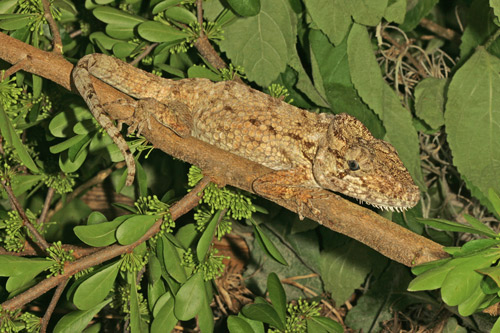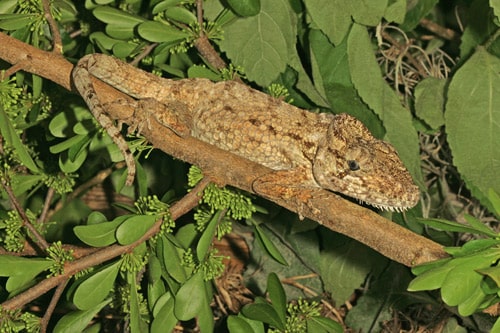Expert breeding tips for the Cuban false chameleon.
Chamaeleolis species, commonly known as Cuban false chameleons, despite the fact that they are really anoles, do not require anything to stimulate breeding. Just make sure you have the Cuban false chameleons paired up and the female is in good body condition. Cuban false chameleons also breed successfully with a single male and multiple females, as long as the cage is large enough. A 29-gallon long aquarium is good for two lizards, and a 50-gallon tank would be good for three to four. When it comes to housing multiple Cuban false chameleons, always only have one male; males fight if kept in the same cage as other males. Watch for aggression between females during egg laying. I house the Cuban false chameleons together year round. Copulation and egg laying is seen during each month of the year. The females never show any clear signs of being gravid, but a behavioral cue is seeing the female sitting on the bottom of the cage. The only time I see the Cuban false chameleons on the floor of the enclosure is prior to finding an egg.

Photo by Paul Freed
Cuban false chameleons (Chamaeleolis porcus) do best when they have thin branches to perch on.
Female Cuban false chameleons lay eggs in the sphagnum substrate; typically, they are completely covered and are about three-fourths of an inch below the surface. Single eggs are laid approximately every 30 days; however, I did have a female reach a peak of one egg every 10 days. This lasts for about seven months. Like other anole species, Cuban false chameleons are capable of delayed fertilization. I had one female Cuban false chameleon continue to lay fertile eggs for up to 6 months after being separated from the male. Be sure to supplement females’ calcium consumption so that egg production doesn’t deplete their health. This is easily done by dusting the crickets with calcium and vitamin D3.
Chamaeleolis eggs average one inch in length and weigh around 4 grams. I incubate my eggs on vermiculite, but perlite will do as well. I never really measure the water to get a specific water-to-medium ratio; I just add water to the substrate until I can use my hand to make a ball that will hold its shape after I let it go. Place the moistened medium in a clean plastic container with the Cuban false chameleon eggs positioned on the surface in the same orientation as they were laid. Push some of the medium around the egg so they don’t roll around. Place a plastic top on the container to prevent moisture from getting out and egg desiccation. Incubate the eggs between 78 to 82 degrees Fahrenheit, and the Cuban false chameleon eggs should hatch between 60 and 70 days.
Raising Young Chamaeleolis
Hatchling Chamaeleolis are very cute. They have shortened snouts and round heads with very big eyes. They average just under 2 inches snout-to-vent length and weigh around 2.5 to 3 grams. I keep babies in setups similar to those of the adults. A 2-gallon glass aquarium is a great size for one hatchling Cuban false chameleon. Place small twigs arranged at 45-degree angle across the length of the tank. Each twig should be three-fourths of an inch to just over one inch in diameter. You can use moist sphagnum moss for Cuban false chameleon cage substrate. I place a small stem of pothos ivy for security, to raise humidity and to provide a drinking surface.
Newly hatched Chamaeleolis are very susceptible to dehydration, so be sure to mist them with a hand spray bottle twice a day. In most cases, Cuban false chameleons won’t drink immediately, but after about 30 to 40 seconds, they usually start licking the perch or a leaf. I mist until the Cuban false chameleons stop drinking. After the first two weeks, I use the drip cup system. Like the adult enclosures, make sure the cage drains properly to avoid saturating the substrate.
Getting new hatchling Cuban false chameleons to eat is pretty easy compared to some species. I feed 2-week-old crickets about three times a week. If you can find small snails (about the size of a pea) you can offer them, too. I usually tong feed crickets to insure that there are no crickets loose in the enclosure. I lightly tap the Cuban false chameleon on the side of the mouth until it opens in a threat display. Then I place the food item on its sticky tongue, and the Cuban false chameleon usually swallows the food on its own.
Chamaeleolis quickly become conditioned to tong feeding and begin to attack the end of the tongs in a strong feeding response. It’s not necessary to tong feed, just be sure to leave some food in the enclosure for loose crickets to eat. Hatchling Cuban false chameleons are even more at risk of injury due to hungry crickets chewing on them. The animals grow quickly; one female offspring began laying infertile eggs at 9 months old.
A Charming Chamaeleolis Anole
Chamaeleolis are fascinating lizards. Larger than your typical anole, they are much calmer and less intimidating than the knight anole. Even though Chamaeleolis have some specific requirements, I believe most reptile enthusiasts will find them a relatively easy species to keep. I have experienced few medical issues with Cuban false chameleons. A few Cuban false chameleons had swollen eyes, but the issue always responded well to antibiotic drops. The most important things to keep in mind concerning Chamaeleolis husbandry are to keep the lizards hydrated and keep them safe from hungry crickets. Follow these suggestions, and you will be well on your way to having happy and healthy Cuban false chameleons.
References
Hass, C.A., S.B. Hedges, and L.R. Maxson. 1993. “Molecular insights into the relationships and biogeography of West Indian anoline lizards.” Biochemical Systematics and Ecology 21:97-114.
Jackman, T., A. Larson, K. DeQueiroz, and J.B. Losos.1999. “Phylogenetic relationships and tempo of early diversification in Anolis lizards.” Systematic Biology 48: 254–285.
Leal, Manuel and J.B. Losos. 2000. “Behavior and ecologyof the Cuban ‘chipojos bobos’ Chamaeleolis barbatus and C. porcus.” Journal of Herpetology 34: 318–322.
Losos, J.B. 2009. Lizards in an Evolutionary Tree: Ecology and Adaptive Radiation of Anoles. Berkeley, California, University of California Press.
Rodriguez Schettino, L. 1999. The Iguanid lizards of Cuba. Gainesville, Florida, University of Florida Press.
Rodriguez Schettino, L, J.B. Losos, P.E. Hertz, K. De Qeiroz, A. R. Chamizo, M. Leal, and V.R. Gonzalez. 2010. “The Anoles of Soroa: Aspects of their ecological relationships.” Breviora No. 520:1-22.


